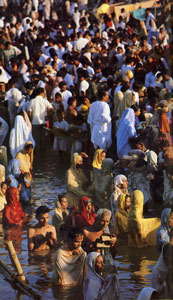
Barbara Bacon
bbacon@canterburyfortmyers.org
Canterbury School, Fort Myers, Florida
| HOME |
| LESSON 1 |
| LESSON 2 |
| LESSON 3 |
| LESSON 4 |
| RESOURCES |
LESSON 3 - THE GANGES AS A SACRED RIVER
PURPOSE
Students will understand the symbolic and religious importance of the Ganges River.
MATERIALS
Index cards or paper
PROCEDURE
This could start as an individual, partner or small group activity and then move into a class discussion.
Distribute index cards/paper and ask students to draw a symbol (natural or human-made) that has great significance to many people. This could be a religious symbol or a secular symbol (e.g., a cross, the Statue of Liberty, Eiffel Tower, Mount Rushmore).
Next, have students write a statement explaining what their symbol. means to large numbers of people.
Then, have students list the people for whom this symbol is especially meaningful.
Have students share their responses with other students.
Discuss some of the examples and why they are significant. Elicit general expectations and attitudes toward a secular and a religious symbol. Are there differences? Would an outsider understand the treatment of these symbols by those who believe in them? Why or why not? Does an explanation of the symbolism help an outsider to understand, even if there is no emotional/cultural/religious connection for that outsider?
Using lecture-and-note-taking, reading or film, establish the significance of the Ganges River as the Hindu sacred river. (See sources.) Caution students to put aside their western attitudes toward pollution and hygiene in order to try focus on understanding the Hindu belief in this river as sacred.
ASSOCIATED VISUALS
 |
"...for most people, it is primarily the rivers which bring comfort and spiritual life. The holy Ganges, in particular, comes out of the mountains and carries spiritual life as well as life-giving water all across the northern plain of India. Hundreds of thousands of people from all parts of India go to its banks daily to sip its water and cleanse themselves....The sacred city of Banaras sits on the banks of the Ganges. It is considered the most auspicious place to die because, after cremation, one's ashes may be floated out on the holy river." (Younger, 7) |
 |
"Often the eyes are the most important part of a sacred icon. They facilitate that most essential climax of all worshp: darshan, seeing and being seen by God. This brilliant red sculpture depicts Hanuman, the Monkey God who is a faithful messenger of Lord Rama." (Huyler, 33) |